
Chaenactis xantiana, the Mojave pincushion or Xantus pincushion, is a flowering plant in the family Asteraceae, native to the western United States, from southeastern Oregon, Nevada, southern and eastern California and northwestern Arizona. It is very common in the Antelope Valley in the Mojave Desert, and grows in sandy soils.

Lupinus bicolor is a species of lupine known as the miniature lupine, Lindley's annual lupine, pigmy-leaved lupine, or bicolor lupine.

Chaenactis is a genus of plants in the family Asteraceae which are known generally as pincushions and dustymaidens.

Chaenactis fremontii, with the common names Frémont's pincushion and desert pincushion, is a species of annual wildflower in the daisy family. Both the latter common name, and the specific epithet are chosen in honor of John C. Frémont.

Erigeron breweri is a North American species of flowering plants in the family Asteraceae known by the common name Brewer's fleabane.

Eryngium aristulatum, known by the common names California eryngo and Jepson's button celery, is a species of flowering plant in the family Apiaceae.

Hazardia squarrosa is a North American species of shrub in the family Asteraceae known by the common name sawtooth goldenbush. It is native to California in the United States and Baja California in Mexico.

Chorizanthe parryi is a species of flowering plant in the buckwheat family known by the common name Parry's spineflower and San Bernardino spineflower.

Camissoniopsis bistorta is a species of flowering plant in the evening primrose family known by the common names southern suncup and California suncup. It is native to southern California and Baja California, where it grows in several types of plant community along the coast and in the coastal hills and mountain ranges. This is a hairy annual or short-lived perennial herb spreading from a basal rosette, with stems reaching up to 80 centimeters long. The leaves are narrow and sometimes toothed, and 1 to 12 centimeters in length. Toward the end of the spreading stems are nodding inflorescences of flowers, each flower with four bright yellow petals dotted with red at their bases.

Chaenactis artemisiifolia, with the common name white pincushion, is a species of flowering plant in the daisy family. It is native to the coastal Peninsular Ranges of Southern California and Baja California, in the chaparral and woodlands.
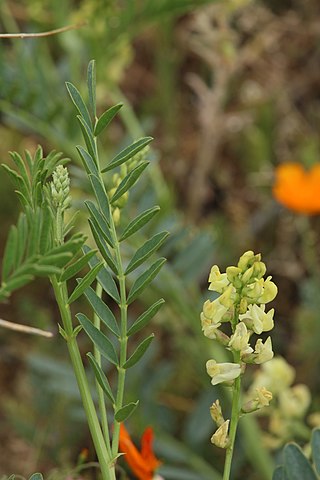
Astragalus douglasii is a species of milkvetch known by the common name Douglas's milkvetch. It is native to California and Baja California, where it can be found in many types of desert, valley, chaparral and woodlands, and montane habitats, usually below 8,000 feet (2,400 m) elevation.
Chaenactis alpigena is a species of flowering plant in the daisy family known by the common name southern Sierra pincushion. It is native to the High Sierra Nevada and the White Mountains of California, extending in the latter just into Nevada.
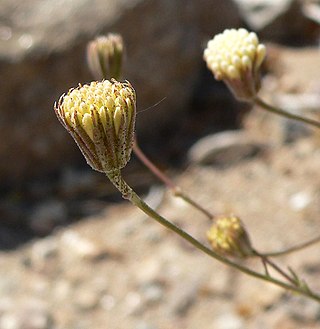
Chaenactis carphoclinia is a species of flowering plant in the daisy family known by the common name pebble pincushion. It is native to the southwestern United States and northwestern Mexico, where it grows in rocky and gravelly habitat, such as the California deserts. The species is found in southern California, Nevada, Utah, Arizona, southwestern New Mexico, Baja California, Sonora.

Chaenactis douglasii is a North American species of flowering plant in the daisy family known by the common name Douglas' dustymaiden.
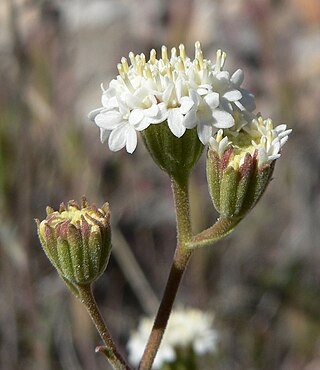
Chaenactis stevioides, with the common names Esteve's pincushion and desert pincushion, is a species of flowering plant in the daisy family. It is also sometimes called false yarrow or broad-leaved Chaenactis.

Chrysothamnus viscidiflorus is an American species of shrub in the family Asteraceae known by the common names yellow rabbitbrush and green rabbitbrush.

Lonicera subspicata is a species of honeysuckle known by the common name southern honeysuckle. It is native to Baja California, California, and northern Baja California Sur, where it is known from several areas in mountain and coastal habitat, particularly chaparral. It is a vining shrub which usually climbs on other plants for support.
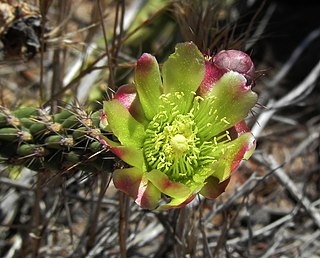
Cylindropuntia californica is a species of cholla cactus known by the common name snake cholla. It is primarily found in Baja California, Mexico and the southernmost part of California in the United States. It is characterized by a short, decumbent habit, yellow-green flowers, elongated stems, and short spines. It is mostly found in coastal sage scrub and coastal chaparral habitats, but two varieties in Baja California can be found in foothills and deserts. In California, variety californica is regarded as a rare and threatened plant, with a California Native Plant Society listing of 1B.1, in part due to its limited number of occurrences and threats from development. It formerly was considered to have a larger range due to the inclusion of Cylindropuntia bernardina within it as the variety parkeri.
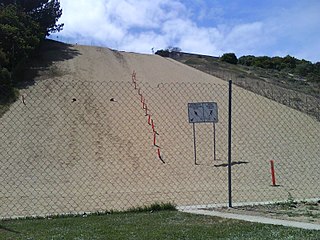
Sand Dune Park is an area of public sand dunes partly on a steep slope that is used for exercise in Manhattan Beach, California. The area has been used by amateur and professional athletes and has been featured in fitness magazines and newspaper accounts as a great workout spot.

Penstemon spectabilis is a species of penstemon known by the common name showy penstemon or showy beardtongue. It is a perennial herb native to southern California and Baja California, where it grows in the chaparral, scrub, and woodlands of the coastal mountain ranges.



















